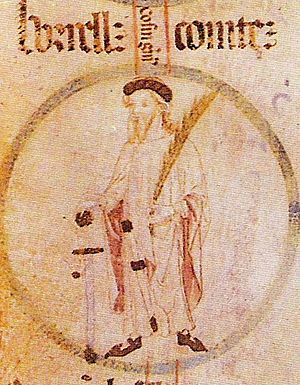Borrell II, Count of Barcelona facts for kids
Quick facts for kids Borrell II, Count of Barcelona |
|
|---|---|
 |
|
| Borel II | |
| Spouse(s) | Letgarda Eimeruda |
| Issue | |
| Ramon Borrell, Count of Barcelona Ermengol I, Count of Urgell Ermengarda Richilda |
|
| Noble family | House of Barcelona |
| Father | Sunyer, Count of Barcelona |
| Mother | Richilda of Toulouse |
| Died | 993 |
Borrell II (died 993) was an important ruler in what is now Catalonia, Spain. He was a Count of Barcelona, Girona, and Ausona starting in 945. He also became the Count of Urgell in 948.
Borrell first started helping his father, Sunyer II, rule in 945. This was during a special church event in Barcelona. In 947, his father decided to retire and live a quiet life in a monastery. He gave control of his lands to Borrell and his brother, Miro I.
In 948, Borrell gained more land when he inherited Urgell from his uncle, Sunifred II. His father, Sunyer, passed away in 950. Later, Miro died in 966. This left Borrell as the only ruler of a large part of Old Catalonia. Because he controlled so much land, some people called him dux Gothiae, which means "Duke of Gothia". But in his own official papers, he usually just called himself comes et marchio, meaning "Count and Marquis".
Contents
Borrell II's Life and Rule
Borrell was the son of Sunyer. He got married twice. His first wife was Letgarda, whom he married in 967. Historians think she might have been from a powerful family in Toulouse or Rouergue.
Borrell's Family
Borrell and Letgarda had four children:
- Ramon Borrell (born 972, died 1017)
- Ermengol (born 974, died 1010)
- Ermengarda
- Richilda
After Letgarda passed away around 986, Borrell married Eimeruda in 987. She might have been from a place called Auvergne.
Diplomacy and Challenges
Borrell was not known for winning many battles. Records show he fought only two and seemed to lose both. A very tough time for him was in 985 when the city of Barcelona was attacked and taken over. A powerful Muslim leader named Almanzor led this attack. Barcelona was looted, and many people were taken prisoner.
However, Borrell was much better at being a diplomat. This means he was good at talking to other leaders and making agreements. Before the big attacks in the 980s, he had good relationships with the Muslim rulers of Córdoba. He also sent messengers to the kings of the Franks. In 970, he even traveled to Rome to meet with Pope John XIII and Emperor Otto I.
Supporting Learning and Culture
Borrell was also a big supporter of education and culture. In 967, he visited a monastery where he met a smart young man named Gerbert of Aurillac. The head of the monastery asked Borrell to take Gerbert with him to Spain. They wanted Gerbert to study mathematics there.
In the years that followed, Gerbert studied near Barcelona. He learned from Bishop Atto of Vic and likely at the nearby monastery of Santa Maria de Ripoll. Gerbert also went with Borrell on his trip to Rome in 970. There, the Pope convinced Emperor Otto I to hire Gerbert as a teacher for his young son, who would later become Emperor Otto II. Gerbert himself later became Pope Sylvester II.
Breaking Ties with France
In 985, the Hispanic March (the border area where Borrell ruled) was attacked by the Muslim general Almanzor. Barcelona was captured, robbed, and damaged. Borrell asked King Lothar III of the Western Franks for help. Borrell's documents show that the king sent orders, but King Lothar couldn't provide actual military help.
Borrell also asked Hugh Capet for help. Hugh wrote back, offering aid if Borrell chose to "obey us rather than the Ishmaelites." But Hugh couldn't convince his own nobles to go on a military trip to the south. We don't know if Borrell ever replied to Hugh's letter. This event effectively broke the connection between Borrell's lands and France.
Many historians in Catalonia now see this as the moment Catalonia became an independent power. In 1987, they even celebrated 1,000 years of their independence. However, some other areas in Catalonia kept their links with the Frankish crown a bit longer.
Later Life and Legacy
From 988, Borrell's sons, Ramon Borrell and Ermengol, started ruling different parts of his lands. Ramon Borrell became Count of Barcelona, Girona, and Osona. Ermengol became Count of Urgell.
Borrell II continued to issue official documents and travel around his lands. In 993, he became ill in Castellciutat, near la Seu d'Urgell. He made a will, expecting to live longer than his executors (the people who would carry out his will). However, he passed away soon after.
See also
 In Spanish: Borrell II para niños
In Spanish: Borrell II para niños

